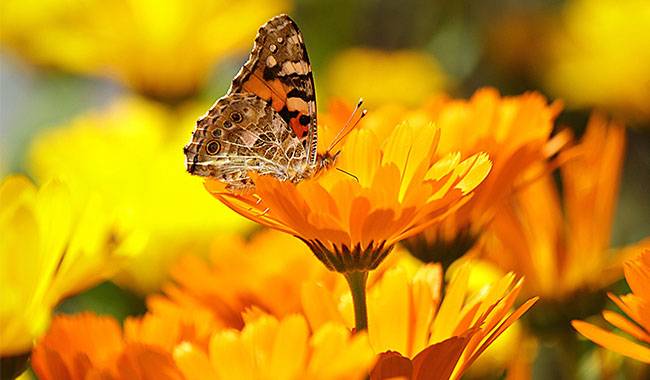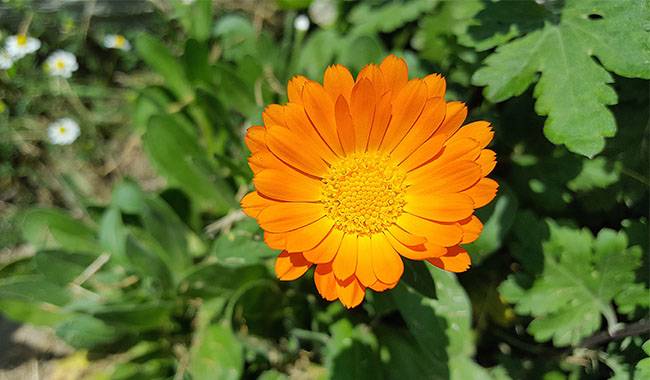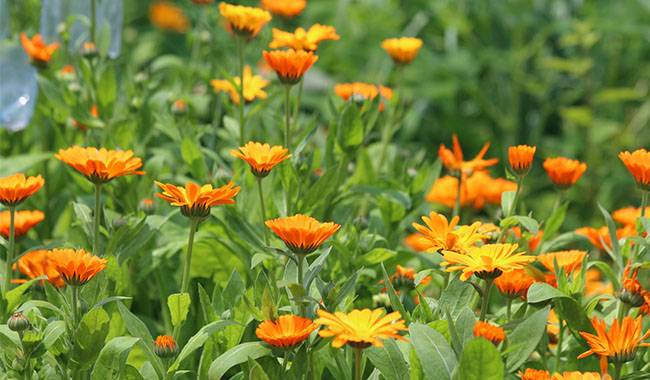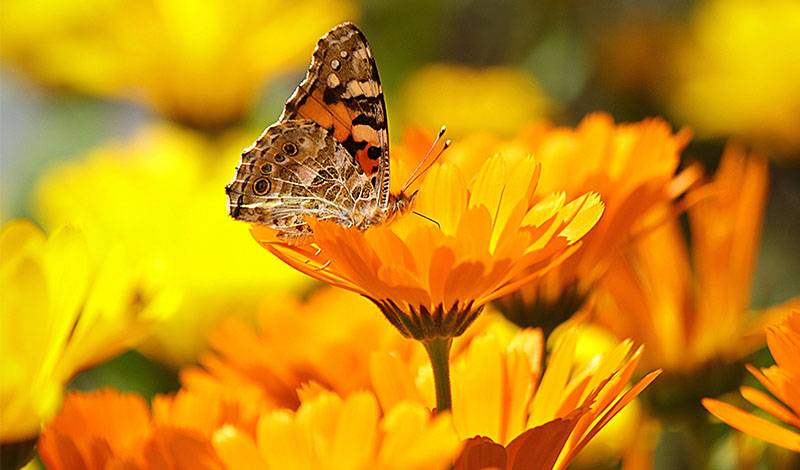
How to grow Calendula, how to plant it from seed, how to take care of it? All the question you might have it’s in this article.
Calendula, or Pot marigold, is a genus of herbaceous plants in the Asteraceae family, native to the Mediterranean, Near East Asia, and Western Europe. The name of the genus comes from the Latin calendar, which means the first day of the month. The genus includes about 20 species of annuals and perennials.
Some of them, such as the medicinal Pot marigold, have medicinal value in addition to their decorative properties and can therefore be found in the works of Theocritus, the ancient Greek philosopher and physician of the first century A.D. Galen, Avicenna, Amidovrat Amasyatsi, and the famous herbalist Nicholas Culpeper also treated Pot marigold in their patients.
It was also used as a vegetable, as a filling for dumplings, puddings, wine, and was added to soups and oatmeal. the Calendula plant was known as the poor man’s spice because the real spices of the East were imported from overseas and were very expensive, and Calendula could be successfully substituted for saffron to give dishes a sour taste and a yellow-orange hue.
Due to its virtues, Calendula was so popular in Europe that Shakespeare himself wrote about it and Queen Marguerite of Navarre, also known as Queen Margot, preferred Calendula to all the flowers in the royal garden.
Planting and care of Calendula Planting
Sowing seeds into the soil – April or October, sowing seedlings – late March or early April, transplanting seedlings – mid-May.
Lighting: full sunlight.
Soil: moist, nutrient-rich, well-drained.
Watering: regular, less frequent watering, more watering during dry periods.
Fertilization: Once a month with compound mineral fertilizer.
Propagation: Seeds.
Insect pests: aphids.
Diseases: powdery mildew, black spot.
Value: Calendula is a medicinal plant with wound healing, analgesic, diuretic, expectorant, anti-inflammatory, sedative, antiseptic, antispasmodic, and restorative properties.
CALENDULA’S PROPERTIES – BENEFITS AND DRAWBACKS
Useful properties
As a medicinal plant, Calendula is grown on an industrial scale. For the manufacture of medicines harvested just opened inflorescences of Calendula, which is a great carotenoid (carotene, yellow pigment, flavoxanthin, rubixanthin, lycopene).
Calendula also contains saponins, paraffin hydrocarbons, mucilage, resins, phytoncides, bitterness, proteins, flavonoids, glycosides, malic acid, salicylic acid, pentadactyl, ascorbic acid, and essential oils.
Calendula is used for wound healing, anti-inflammatory, antibacterial and antispasmodic. It is used in the treatment of neurological and medical disorders as a sedative, diuretic, expectorant, analgesic, and restorative agent.
Calendula preparations help to relax the smooth muscle structures of the stomach, liver, and intestines, thus enhancing bile formation, bile secretion, and secretory activity of the stomach. On streptococci and staphylococci, Calendula acts as a strong antibiotic, but has no such destructive effect on the body and has no side effects.
In the preparation of some skin diseases (psoriasis, allergic skin diseases, vitiligo) Calendula is taken internally and externally. an aqueous solution of Calendula tincture is effective in the treatment of stomatitis, tonsillitis, sore throat, reduction of bleeding gums.
Calendula ointment treats burns, cuts, chapped skin, bruises, and eczema. Calendula oil is effective in the treatment of varicose veins, bedsores, dry eczema. It is also recommended for internal use in gastritis, gastric and duodenal ulcers, liver disease, colitis, enteritis. The drug reduces the nervous symptoms of neurasthenia and menopausal diseases.
Calendula and good cosmetics: washing the hair with Calendula infusion combined with chamomile and hops cone in equal parts improves the appearance and condition of the hair and scalp.
Contraindications
Application of Calendula preparations during pregnancy, hypotension, heart failure, and individual intolerance to the product. However, even if you do not belong to the risk group, it is wise to consult a doctor before starting Calendula preparation.
BOTANICAL DESCRIPTION
Calendula is an herb with glandular-pubescent, orange or yellow basket-like inflorescences consisting of outer pistillate fruiting pseudotigers and inner tubular sterile flowers, sometimes darker in color.
The leaves of Calendula are simple, alternate, elliptic, lanceolate, or elongate. The curved, sometimes ring-shaped seeds, the fruits of Calendula, are arranged in 2-3 rows.
Calendula flowers from June to November bears a lot of fruit and the seeds remain germinating for more than 5 years. Sixteenth-century decorative flowers in Calendula.
GROWING CALENDULA FROM SEED
How to sow
It is easiest to sow seeds in the open ground in April or under winter in October. In spring, when the snow has melted and the ground has warmed and dried sufficiently, take a handful of garden soil and drop it on the ground from a height of about 40inch (1 meter) and if it breaks easily, you are ready to sow Calendula.
A few weeks before sowing, turn the soil of the plot at a rate of 3-4 kg per square meter, adding 20 g of superphosphate and potassium chloride and 30 g of urea per unit area.
Of course, it is better to dig out an area with humus, phosphorus, and potassium additives in the autumn, so that before sowing in the spring, only nitrogen fertilizer is left.
Calendula seeds are sown into the ground at a depth of 0.4-0.8inch (1-2 cm), spaced 10-12inch (25-30 cm) apart from each other, and about 24-28inch (60-70 cm) between row leaves, if you are growing Calendula for its decorative qualities, but if you need Calendula as medicine, the spacing between the row leaves can be less 12-16inch (30-40 cm).
In this case, and the distance between rows of seeds can be reduced to 2.8-4inch (7-10 cm). Within 2-3 weeks after the emergence of sprouts (properly planted seeds already start sprouting within a week), the seedlings are thinned out, ending up with 10-14inch (25-35 cm) spacing between seedlings.
“Extra” seedlings can be planted immediately in another location – Calendula is perfectly tolerant of transplanting. Calendula blooms in about 10 weeks from sowing to outdoor.
SOWING CALENDULA SEEDLINGS
If you want early flowering, you can use the seeding method. Low-growing Calendula should also be planted. seeds are sown in late March or early April in plain containers or in separate cups with flowering soil to a modest depth of no more than 0.8inch (2cm).
Cover the seeds in containers with aluminum foil and keep them at a temperature of 64-68°F (18-20ºC) in a bright, but protected from direct sunlight.
SEEDLING CARE
When seedlings emerge (usually after 6-8 days), remove the aluminum foil and lower the temperature to 57-59°F (14-15ºC). Care of Calendula at this stage consists mainly of watering the soil and feeding the seedlings with a weak solution of a mineral complex fertilizer once every ten years or two weeks.
At the seedling development stage, when there are two true leaves, the seedlings are planted in cuttings or split cups at a distance of 2inch (5cm) between portions.
GROWING CALENDULA OUTDOORS
When to plant
Plant Calendula flowers in the open ground when the seedlings have developed to 5-6 true leaves – usually this happens in mid-May. However, despite the fact that Calendula plants are hardy and can quietly withstand spring night frosts, it is necessary to go through the procedure of hardening with seedlings before planting.
To do this, place the box or container on a balcony or roof patio for a few days a day for a week.
The planting site should be sunny and the soil should be well-drained, moist, and nutrient-rich. Experienced gardeners plant Calendula between beds of other garden and vegetable crops to protect them from mites, butterflies, and their larvae.
However, its roots release substances into the soil that may slow the growth of radish or basil plants planted nearby. Take this into account when selecting a site.
How to plant
The scheme for growing Calendula in the ground is the same as for sowing: keep the rows 10-12inch (25-30 cm) apart between specimens for ornamental, 2.8-4inch (7-10 cm) apart for medicinal, leave a width of 23-28inch (60-70 cm) for decorative and Calendula starts flowering 40-50 days after sowing seedlings.
CALENDULA CARE IN THE GARDEN
Planting conditions
Growing and caring for Calendula requires neither special conditions nor a lot of effort. The usual things: watering in dry weather, loosening the soil, weeding, monthly cultivation with compost.
One thing is certain: if you want Calendula to produce lush flowers for a long time, cut off all the open flowers when the ligulars are horizontal. This measure promotes the formation of many flower buds and allows lush flowering to continue into late autumn.
However, you should always collect fully open baskets of flowers. If you do not do this, Calendula’s flowering will not last until the end of July.
Propagation
Calendula is propagated by seeds.
PESTS AND DISEASES
The fungal diseases black spot or powdery mildew occasionally affect Calendula.
Black spot causes black or brown spots to appear on the leaves. Powdery mildew forms a white film on the above-ground parts of the plant that turns brown over time, causing Calendula to lose its decorative qualities and the affected areas to stop developing and turn black.
Even a slight infestation of this disease can cause a significant decrease in Calendula’s cold tolerance. If immediate and drastic measures are needed, treat Calendula spots or dew with fungicides.
However, it is best not to be lazy and, in the case of very intensive planting, to focus on prevention, thinning out Calendula, timely weeding, following the amount of fertilizer introduced into the soil, especially nitrogen fertilizer, so that its saturation of the soil does not occur, carefully clearing the site of plant debris in the fall, tilling the land deeply for the winter, following a crop rotation and, of course, immediately removing diseased plants from the site.
Among the pests, Calendula can only suffer from aphids, the rest of the insects it repels. As for aphids, it seems that Calendula suffers, collecting all the aphids from the whole garden. It is possible to control aphids on Calendula with carbosulfuron (insecticide), as well as with chlorothalonil (protective fungicide).
As you can see, growing and caring for Calendula in the open ground is not complicated.
CALENDULA AFTER FLOWERING
How and when to collect seeds
The seeds of Calendula should be collected when they are almost fully mature. In order not to be late, put a gauze bag over the faded inflorescence, into which the mature seeds will fall. the problem with Calendula seeds is that they do not mature, so do not skip the maturity period. Otherwise, there is a high risk of self-seeding.
Calendula in winter
Garden Calendula is an annual crop, so in the autumn, its plant remains are disposed of and the plot is plowed.






